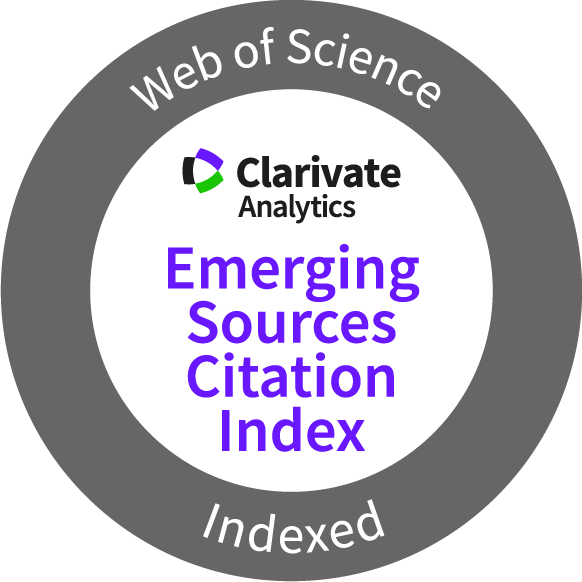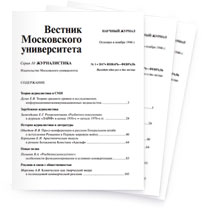Citation Approaches of Russian Media Researchers in the Context of Internationalisation of Russian Science
Download paperPhD in Philology, Senior Lecturer at the Chair of Photojournalism and Media Technologies, Faculty of Journalism, Lomonosov Moscow State University, Moscow, Russia; ORCID 0000-0002-9199-8069
e-mail: igor.anisimov@gmail.comPhD in Philology, Associate Professor at the Chair of Media Theory and Economics, Faculty of Journalism, Lomonosov Moscow State University, Moscow, Russia; ORCID 0009-0002-6457-7063
e-mail: makeenko.mikhail@smi.msu.ruPhD in Philology, Senior Researcher at the Chair of New Media and Communication Theory, Faculty of Journalism, Lomonosov Moscow State University, Moscow, Russia; ORCID 0000-0002-6834-6206
e-mail: natahatri@yandex.ruSection: Theory of Journalism and Media
The article contains the results of the metadata analysis of 2011 scientific articles on media and communication published by researchers with Russian affiliation in journals indexed in the international database Web of Science (WoS) in 2017–2021. The analysis of references revealed differences in approaches to source selection in the case of all articles and those published in foreign journals in WoS, excluding ESCI (221 publications). In the latter, foreign sources are cited significantly more often, while in general foreign literature is still quite rare and used only to a limited extent by domestic researchers. Among Russian sources most recent articles are usually cited, which may be due to close ties within a small community of authors, as well as the recent formalisation of domestic media and communication research as a separate discipline. There is a clear tendency to cite domestic colleagues, in case of Russia this phenomenon is closely related to some isolation of scientific journals in Russian, the language barrier and not particularly developed personal ties with foreign researchers.
DOI: 10.30547/vestnik.journ.4.2024.323References:
Akoev M. A. (ed.) (2021) Handbook on Scientometrics: Science and Technology Development Indicators, Second edition. Yekaterinburg: Ural State Univ publ. (In Russian)
Gilyarevsky R. S. (2022) On the incorrectness of using citation indexes for calculations on the comparison of sections of science. Nauchno-tekhnicheskaya informatsiya. Ser. 2. Inform. protsessy i sistemy 2. Available at: https://www.elibrary.ru/download/elibrary_48613524_87035806.pdf (accessed: 20.10.2023). (In Russian)
Makeenko M. I. (2018) Napravleniya transformatsii teoreticheskikh podkhodov v rossiyskikh issledovaniyakh vliyaniya tsifrovizatsii na media [Transformations of Theoretical Approaches to the Impact of Digitalization on Media in Modern Russian Media Research]. Mediaskop 3. DOI: 10.30547/mediascope.3.2018.1. (In Russian)
Makeenko M. I. (2017) Elaboration of media theories in russian academic journals in the 2010s: results of the first stage of rhe research [Razvitie teoriy media v rossiyskikh nauchnykh zhurnalakh v 2010-e gg.: rezul'taty pervogo etapa issledovaniy]. Vestnik Moskovskogo Universiteta. Seriya 10. Zhurnalistika 6: 3–31. (In Russian)
Merton R. K. (1993) Effekt Matfeya v nauke, II: nakoplenie preimushchestv i simvolizm intellektual''noy sobstvennosti [The Matthew Effect in Science, II: Cumulative Advantage and the Symbolism of Intellectual Property]. THESIS 3. Available at: https://www.hse.ru/data/033/314/1234/3_6_1Merto.pdf (accessed: 20.10.2023). (In Russian)
Ai M., Masood M. (2021) De-Westernization in journalism research: a content and network analysis of the BRICS journals. Scientometrics 126: 9477–9498. DOI: 10.1007/s11192-021-04194-5
Bookstein A., Yitzhaki M. (1999) Own-language preference: A new measure of “relative language self-citation”. Scientometrics 46: 337–348. DOI: 10.1007/BF02464782
Bradford S. C. (1934) Sources of information on specific subjects. Engineering. 137:85-6.
Chubin, D. E., Moitra, S. D. (1975). Content Analysis of References: Adjunct or Alternative to Citation Counting?. Social Studies of Science 5 (4): 423–441. DOI: 10.1177/030631277500500403
Di Bitetti M. S., Ferreras J. A. (2017) Publish (in English) or perish: The effect on citation rate of using languages other than English in scientific publications. Ambio 46: 121–127. DOI: 10.1007/s13280-016-0820-7
Lancho-Barrantes B. S., Bote G., Vicente P., Rodríguez Z. C., de Moya Anegón F. (2012). Citation flows in the zones of influence of scientific collaborations. Journal of the American Society for Information Science and Technology63(3), 481–489.
Latour B., Woolgar S., Salk J. (1986) Laboratory Life: The Construction of Scientific Facts. Princeton, N. J.: Princeton University Press.
Liang L., Rousseau R., Zhong Z. (2013) Non-English journals and papers in physics and chemistry: bias in citations?. Scientometrics 95: 333–350. DOI: 10.1007/s11192-012-0828-0
Liu F., Hu, G., Tang, L., Liu W. (2018) The penalty of containing more non-English articles. Scientometrics 114: 359–366. DOI: 10.1007/s11192-017-2577-6
Liu W. (2016) The changing role of non-English papers in scholarly communication: Evidence from Web of Science's three journal citation indexes. Learned Publishing 30: 115-123. DOI: 10.1002/leap.1089
Merton R. K. (1973) The Sociology of Science: Theoretical and Empirical Investigations. Chicago: University of Chicago Press. Available at: https://www.press.uchicago.edu/ucp/books/book/chicago/S/bo28451565.html (accessed: 20.10.2023).
Moravcsik M. J., Murugesan P. (1975) Some Results on the Function and Quality of Citations. Social Studies of Science 5: 86–92.
Nicolaisen J. (2004) Social Behavior and Scientific Practice – Missing Pieces of the Citation Puzzle. PhD thesis.Available at: https://www.researchgate.net/publication/247562092_Social_Behavior_and_Scientific_Practice-Missing_P... Citation_Puzzle (accessed: 20.10.2023).
Schwarz A. W. (1999) Scientific centres in Europe: An analysis of research strength and patterns of specialisation based on bibliometric indicators. Urban Studies 36 (3), 453–477.
Kunnath S.N., Herrmannova D., Pride D., Knoth P. (2022) A meta-analysis of semantic classification of citations. Quantitative Science Studies 2 (4): 1170–1215. DOI: 10.1162/qss_a_00159
Thelwall M., Maflahi N. (2015) Are scholarly articles disproportionately read in their own country? An analysis of mendeley readers. J Assn Inf Sci Tec 66: 1124–1135. DOI: 10.1002/asi.23252
Wouters P. (1998) The Signs of Science. Scientometrics 41 (1–2): 225–241. DOI: 10.1007/BF02457980
Wouters P. (1999) Beyond the Holy Grail: From Citation Theory to Indicator Theories. Scientometrics 44 (3): 561–580. DOI: 10.1007/ BF02458496
To cite this article: Anisimov I. V., Makeenko M. I., Trishchenko N. D. (2024) Podkhody rossiyskikh issledovateley media k tsitirovaniyu v kontekste povysheniya mezhdunarodnoy vidimosti otechestvennykh nauchnykh publikatsiy [Citation approaches of Russian media researchers in the context of internationalisation of Russian science]. Vestnik Moskovskogo Universiteta. Seriya 10. Zhurnalistika 4: 3–23. DOI: 10.30547/vestnik.journ.4.2024.323






